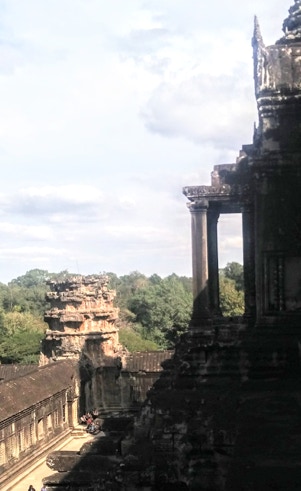VI. THE KHMER CONTEXT:
Evolution of the Temple Mountain at Angkor

Borobudur proved a heteroclite, a prototype without copies; perhaps it so fully realized the potential for a monument to be both a mandala and a mountain no Indian or Khmer ruler was devout or ambitious enough to be tempted to surpass it. The Ananda Temple (1050-1100 C.E.) at Bagan, for example, has 1500 Buddhas lining the 15m tall walls of its two interior corridors – the equivalent of internal terraces – while its upper terraces are lined with 547 plaques illustrating each of the jataka or “birth stories” of Buddha’s previous incarnations. Most, however, are too high for anyone to see, since the temple was built for “merit,” credit against the monarch’s karmic debt, not for the edification of his subjects. This may reflect the difference between Ananda’s Theravada Buddhism, where release is earned over many reincarnations and the Mahayana possibility for enlightenment in a lifetime illustrated at Borobudur. The immense Khmer temple mountains documented in this album also don’t emulate Borobudur’s well-defined didactic purpose; their terraces may be larger but we still don’t know what their use was; their bas-reliefs depict a gallimaufry of monarchical glorification, recent history and episodes from the two Hindu epics but lack Borobudur’s step-by-step curriculum for novice bodhicittas.
There is no sign the builders of the Baphuon or Angkor Wat were even aware of their illustrious predecessor. In many ways, Angkor Wat seems almost the antithesis of Borobudur whose solid mass might have struck Khmer builders and kings as merely squat or squashed and inappropriate for the ordered spaciousness of an expanding empire. At Borobudur the architects seem deliberately to have constructed a confined, linear and ultimately private experience of space between its walls and balustrades, unspooling like a film around each redented corner, twisting but climbing steadily upward along an unfolding path towards a conclusion that could only be experienced by reaching it. In this labyrinth, one can imagine, initiates could gradually shed their samsaric illusions of occupying a personal position in architectural and terrestrial space, erasing the dualism of here and there, self and other. The uneventful, often repetitious, story of Sudhana and his fifty-two “friends” numbs the scopophilic gaze grasping for exciting drama, pomp and opulence, so amply rewarded in Angkor Wat’s 1st gallery; it is often difficult to link the carvings on Borobudur’s upper tiers to the Gandavyuha’s text because the scenes differ so little. When adepts finally emerged on the upper terrace, their attention would not have been directed at an expansive vista around them framed by open colonnades, the imperial domain stretching to the Cambodian plain’s horizon, instead they would have seen the volcanos hemming in the Javanese temple. In any event, had they followed Sudhana’s lessons closely, they would be facing away from them, squinting into the cramped dagobas with their Buddha statues in teaching mudra, pointing out the emptiness of the external world to a spaciousness not of the eye. As the pilgrims circled the three narrowing rings of dagobas, the landscape always at their back, their view would be directed upward by the stupa with its vacant chambers, tapering until it disappeared at its dimensionless apex.
This contrasts markedly with the spatiality created at Angkor Wat and the Baphuon with their scenographic evocation of an ideal mountain range, each peak hierarchically aligned around the central shikhara, the summit of Mt. Meru, a comprehensible monumentality in which they were clearly situated. This order extended outward, not just inward, beyond the temple’s enclosures to the surrounding plain, aligning in its orthogonal grid the great barays, canals and roads stretching to the furthest limits of the Khmer realm, reminded at each point along the way by a replica of the gigantic Khmer prasat at its center. The temple’s designers created a crisply defined, classically balanced alternation of negative and positive spaces, where the location of any part within the whole could be inferred from its relationship to the hierarchy of galleries arrayed around the central tower, where the devaraja cult was enacted and, for that moment, the god made his home. The time would come – in only thirty years – when this seemingly immutably structured universe would rupture and collapse, perhaps replaced by something more alien than Borobudur’s Mahayana Methodism – the Vajrayana trance and out-of-body experience which is the Bayon.
Beyond aesthetic preferences and dynastic vanity, there were no doubt more prosaic factors which contributed to Angkorian indifference to such a conspicuous Javanese prototype. Khmer kings prior to Jayavarman VII (1181-1220 C.E.) were officially Hindu, as were their temples, so Borobudur might not have seemed an appropriate model. There is evidence that the Sanjavas’ Hindu shrines at Prambanan did influence earlier Khmer temples, including their basic shrine or prasat module (or aedicule) and the tendency to project free-standing replicas around it. Moreover, Khmer temples may have served a symbolic rather than didactic function and symbols lose their aura the more the implicit is made mundanely explicit. While the theological program of Borobudur has gradually divulged itself to scholarly inquiry, the purpose of Angkor’s “temple mountains” still largely eludes us.
LINTEL 4TH EAST GOPURA, ANGKOR WAT (1113-1150)
VIEW TO THE NORTHWEST, 3RD TERRACE,
ANGKOR WAT (1113-1150)
